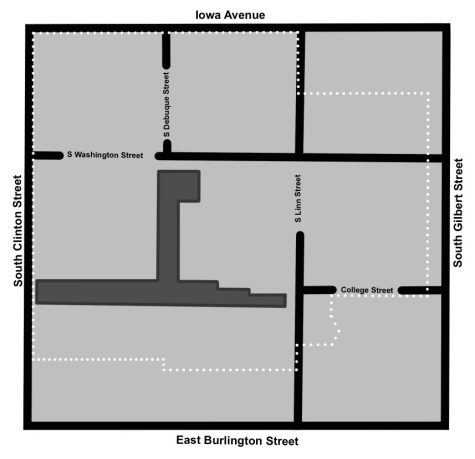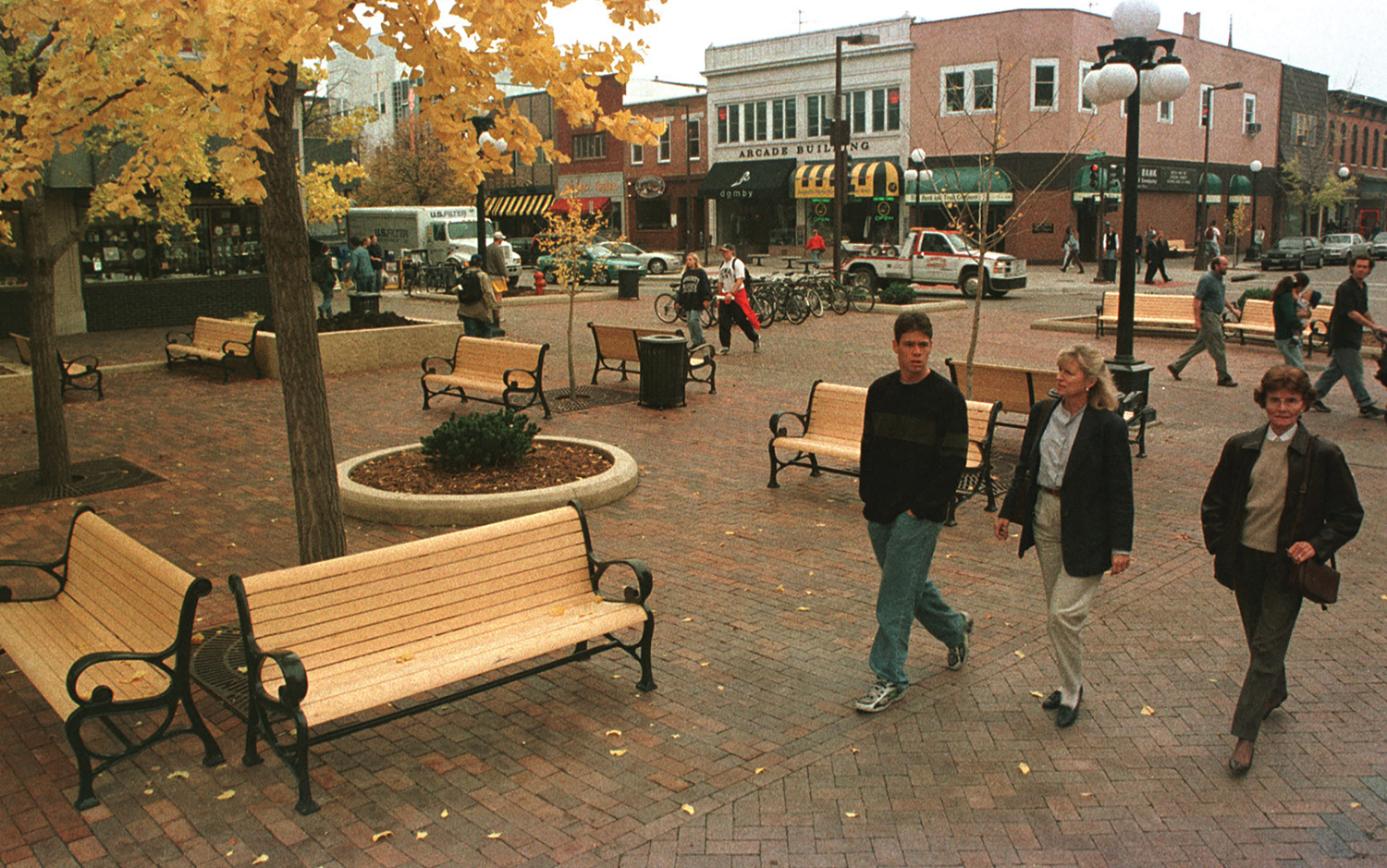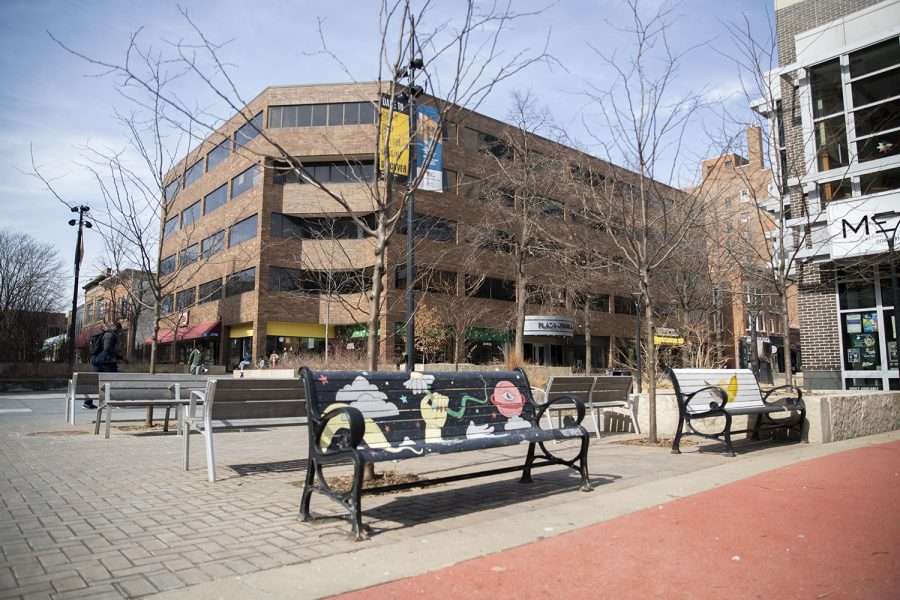Past, Present, Future: Origin of the Iowa City Pedestrian Mall
Since 1979, the Iowa City Pedestrian Mall has been the epicenter for city activity.
March 20, 2022
This is the first part of a project series on the Pedestrian Mall.
It’s a Sunday spring morning and the Iowa City Pedestrian Mall is waking from hibernation.
Children play on the playground next to the Iowa City Public Library, bouncing on the spongy material, screaming joyfully. People lounge on the stone steps leading down to the fountain, basking in the sunlight and talking while cello music fills the air. There is a musician perched on the stage next to the Graduate Hotel, entertaining those walking through the mall while hoping to get a tip.
People enter The Dandy Lion, inviting the smells of syrup and bacon to waft out every time the door opens. The benches outside Bread Garden Market are free of snow and occupied once more by students, kids, parents, and elderly, all chattering away about their weekday plans.
It can be hard to imagine that the area, used daily and beloved by many today, was not always wanted by the Iowa City community.
In 1960s Iowa City, Dubuque and College Streets intersected where the Weatherdance fountain — a series of waterspouts that shoot out water from the ground, forming a tunnel when all spouts are active — now entertains children and families on hot summer days. Now a center for the Iowa City community, the area was a center for commerce in the ‘60s.
Colorful Chevy Impalas and Ford Pintos lined the streets, parked and awaiting their owners to return from shopping at JCPenney and Things & Things & Things.
The Iowa City Pedestrian Mall, affectionately known to many as the Ped Mall, City Plaza, and the Dubuque-College Street Mall, has been a downtown staple for students and community members alike. However, this Iowa City activity hub would not change for another 10 years.
The idea of urban renewal spread rapidly throughout the U.S. during the ‘60s and ‘70s. Cities and towns, desperate to compete with the growing popularity of shopping malls, turned to urban renewal to rejuvenate their dying downtowns.
Iowa City was no different, creating its own urban renewal plan in 1962 that included a version of the original Ped Mall, before the later construction in the ‘80s and ‘90s.
Today, the Ped Mall is one of the 11 remaining pedestrian malls that came out of urban renewal projects across the U.S.
The initial project was fraught with multiple scandals over the years. It was over a decade after the initial proposal in the ‘60s that the urban renewal project even began as a slew of lawsuits muddled any progress. See the timeline above for details.
RELATED: UI campus, student population evolves over 175 years
In October 1973, the city opened the downtown project to bids. The winner — and lone bidder — was Old Capitol Associates, a local building company which then signed a contract in March 1974 to serve as the single developer of the urban renewal parcels.
As construction loomed near in 1974, a case stating that the Environmental Impact Statement filed for the project was inadequate halted the building once again. Though the case was eventually dismissed, it was not until November 1976 and construction could not begin until it was over.

In 1976, a case brought against Iowa City by Charles Eastham, Harold Becholdt, and Jeanne Smithfield found that the city’s urban renewal redevelopment contract with Old Capitol Associates was invalidated due to faulty bidding procedures. After bids were received from the single developer, the city had negotiated terms other than those originally advertised.
It was after this lawsuit that the city hired Zuchelli, Hunter and Associates to assist with the urban renewal process and plans. The city was required to put the urban renewal parcels back on the market to be bidded upon by multiple developers, and create a new urban renewal plan, which occurred in 1977.
In March 1977, the urban renewal plan was accepted by the city council. The final design for the Ped Mall was given to city council in October 1977, though construction started in the late summer of 1977. Jack Leaman of Associated Engineers, Inc., in Mason City, Iowa, was designated as the designer of the mall, according to the Iowa City Historical Society archives.
Iowa City citizens were never completely sold on the idea of urban renewal or the Ped Mall, said Dale Helling, who served as Iowa City assistant city manager from 1978 to 2011.
“I was here in grad school when they were still wrestling with the whole idea, particularly of the downtown and whether the Pedestrian Mall would be appropriate down there, because this was in the ‘70s,” Helling said. “We were, even then, automobile-oriented, and people expected to go downtown and park in front of wherever they were going to go.”
The concept of an extensive space where streets were blocked off to car traffic was new to the Iowa City community, Helling said. While it was an idea that was growing all over the nation, there was still a lot of controversy about whether it was appropriate for Iowa City.
The Iowa City City Council often had heated debates before ultimately deciding to go ahead with the Ped Mall project. Even after the plans were approved, people remained unhappy, Helling said.
“There was that real rough spot between the time that we said, ‘We’re going to do this’ and ‘We’re going to tear it out’ to the time when it started taking shape, and people could see it was going to be reasonably nice,” he said.
Helling said he attempted to win people over by showing them pictures of a pedestrian mall built in Boulder, Colorado, created by Jack Leaman of Associated Engineers, Inc., in Mason City, Iowa, the same person who designed Iowa City’s Ped Mall.
The Ped Mall currently stands on the path of College and Dubuque Streets. Initially, the project was viewed as not only an inconvenience to shoppers, Helling said, but to shop owners, as well.
“There was a lot of consternation among the businesses, because it was harder to get access to their property because the street was torn up, but there wasn’t yet a Pedestrian Mall to replace it,” Helling said. “That was the shopping hub for Iowa City, and it was just torn up and that made a lot of people unhappy about a lot of things.”
In the book The Iowa City Story: “A Matter of Opinions,” Rosalind Moore, then-owner of Fanfare’s Shoes, is quoted saying that business owners had to get creative as their locations were destroyed for urban renewal construction.
In August 1977, while Washington Street was being rebuilt, they had Sidewalk Days where merchants publicized the unwanted construction that was occurring downtown, she said.
“The biggest problem we had as merchants was the way parking just kept disappearing. There was no place for our customers to park,” Moore said. “We finally got them to pave a temporary parking lot on the land that was cleared for the shopping center. It was essential if we were to keep customers coming downtown —especially during the Christmas business.”
After over 10 years of plans and two years of construction, the Iowa City Ped Mall was dedicated as City Plaza on Sept. 22, 1979, with an eight-day celebration with live music, guest speakers, and children’s activities. While the Ped Mall section of urban renewal was complete, construction on the Old Capitol Town Centre began in May 1979 and continued until its opening in 1981.
“Seventeen years and countless thousands of bricks later, the end is in sight. Governor Robert Lucas Square officially opens Sept. 22-29, with an eight-day celebration of music, dance, visual art and activities for all ages entitled ‘Art Surrounds the Plaza,’” reads a 1979 edition of The Daily Iowan.
The completed Ped Mall featured trees and shrubbery, timber planters, brick paving, a playground area with equipment, and a multi-tiered brick fountain with large, steel pipes at the intersection of Dubuque and College Streets.
According to a 1992 edition of the DI, the fountain, informally called “Three Women Peeing” by the community, cost $80,000 and was funded through donations collected by Project Green.

The mall originally extended all the way to Burlington Street, but it was cut off when the $13 million addition of the Holiday Inn hotel was built in 1984. The Graduate hotel currently occupies the original Holiday Inn building.
The success of the Ped Mall resulted in the need for the bricks to be replaced, which occurred in 1999. Karin Franklin, who served as Iowa City’s director of planning from 1991 to 2007, said the bricks were uneven by the time the city looked to replace them.
“We had some debate within the staff about whether to put bricks or just concrete and the reason was that some people felt that the bricks were too slippery,” Franklin said. “I was not one of those people. I really prefer the bricks — I think it makes it distinctive.”
The 1999 Ped Mall project also included the replacement of the original 1970s fountain. The original structure was removed out of worry for the safety of children who would play in the fountain in the summer. While the original fountain was nice to look at, Franklin said, it was not meant to be interactive.
“The fountain that was there before, it had steps, and so it really wasn’t great for little kids to be on because if you take a header off of that, you can really hurt yourself,” she said. “The flat fountain with the Weatherdance design […] was seen as something that was going to be a lot safer and enable broader participation of actual activity in the fountain as opposed to just looking at it.”
Now, the center of the Ped Mall is accompanied by a different type of structure. While children used to climb all over the bricks of the old fountain and splash in the pool of water it housed, they now can run through streams of water instead.
The Weatherdance Fountain came from the Iowa City community, Franklin said. The water in the fountain shoots up from the ground accompanied by colorful lights at nighttime. The water spouts up at different times depending on the pattern that is running.
The Iowa City Public Art Advisory Committee put out a call to Iowa City community artists to submit ideas for the fountain.
The Weatherdance Fountain was one of the first Iowa City Public Art Program projects, Franklin said. It was essential to the group to focus on the Ped Mall, she said, as it is considered by many as the center of downtown.
“We always looked at it as kind of the heart of the community,” Franklin said. “That was the place to invest in improvements and invest in public art, which was intended to kind of show what the heart of the city was, what the heart of the community was, and emphasize the art focus that a lot of people in Iowa City have.”
Timeline by Molly Milder/The Daily Iowan
The final major aspect of the 1999 renovations focused on giving the original Ped Mall plants real planters.
“The planters were all these railroad ties. The wood, it’s treated in time, it gets rotty,” Franklin said. “Those were replaced with either brick, concrete, or stone faces. A couple of those planters, embedded within the side of the planter, [have] images that were related to the fountain, like clouds.”
Franklin said she feels the Ped Mall remains special to this day, even with all the changes it has endured.
“A lot of cities […] would open their Ped Mall back up and put the streets back in because businesses wanted access to the street, parking and all that kind of stuff,” Franklin said. “Ours stuck, and I think there probably would have been a significant rebellion if we’d ever tried to get rid of the mall.”
The Ped Mall is currently undergoing another overhaul, with the Minnesota-based Tailwind Group bringing a $56 million redevelopment to multiple buildings along College Street. The new Riverside Theatre is part of the project, as well as the upcoming ReUnion Brewery.
Today as the weather improves, it is not unusual to see students meandering around the Ped Mall during the day, wandering in and out of Aspen Leaf, frozen yogurt in hand and spoons in their mouths.
At night, people wait to get into Brothers bar, as music pumps loudly out of the open doors, the windows allowing an observer to see the crowd indoors. Blue and red lights illuminate the trees, lighting the way for social goers to enjoy the nightlife.
Every day, people continue to use the Ped Mall as a breeding ground for lifelong memories and experiences, as they have since 1979.
“I think the Ped Mall is one thing Iowa City can be very proud of,” Franklin said. “I know the community values it and when people come from out of town, it is something that is special for our city.”

